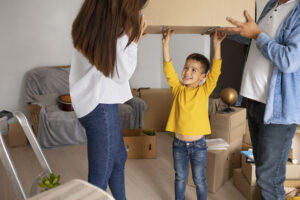How to Move with Kids: Tips for a Smooth Transition
Get Your Free Moving Estimate
Moving with kids can be tough, but it’s also a chance for growth and new adventures. You’re about to start a family move that needs careful planning. This ensures a smooth transition for your kids. A successful move means picking the right time, making a moving plan, and budgeting for family costs.
A vibrant illustration of a cheerful family packing boxes in a cozy living room, surrounded by colorful toys and stuffed animals, with a partially open front door revealing a sunny outdoor scene, and moving boxes stacked around, creating a sense of adventure and excitement for the upcoming move.

When moving your family, put your kids first. Make the move as easy as you can for them. By doing this, you can turn your family move into a positive experience. This leads to a smooth transition to your new home.
Introduction to Moving with Kids
Moving with kids needs careful thought about their needs and feelings. Focus on making the move easy for them, from planning to the actual move. A family move is a big change for kids. But with the right steps, it can also be a chance for growth and new experiences.
Key Takeaways
- Plan carefully to ensure a smooth transition for your kids
- Consider the best time to move during the school year
- Create a moving timeline to stay organized
- Budget for family-related moving expenses
- Prioritize your kids’ needs and feelings during the move
- Make the moving process as stress-free as possible for your kids
- Focus on making the transition to your new home a positive experience for your family
Planning Your Move with Kids: Essential First Steps
When planning a family move, think about the best time to move and create a timeline. A moving checklist for kids helps keep everything organized. Start by figuring out the best time to move during the school year. This affects your kids’ education and how well they adjust to the new place.
Moving with kids can be tough, but good planning helps. Make a timeline for your family’s move to stay on track. Don’t forget to budget for moving costs like food, travel, and where to stay. This helps avoid money worries.
- Evaluate the Best Time to Move During the School Year: Consider the timing of the school year when planning the move. Moving mid-year might disrupt your kids’ education, while summer or holiday breaks could be easier on them. Plan around their school schedule to reduce the impact.
- Create a Moving Timeline: Set a timeline that outlines each step of the move, from packing to arrival at your new home. This helps everyone stay on track and makes the process feel less overwhelming. Be sure to include deadlines for packing, moving day, and setting up the new home.
- Budget for Family-Related Moving Expenses: Moving can be expensive, especially when you have a family to consider. Include costs like transportation, food, temporary accommodations, and even special expenses for your kids, such as their travel comfort or entertainment. Having a budget ensures that you won’t have any financial surprises.
- Get Help If You Need It: If you’re not quite ready to handle the move on your own, consider hiring professional movers. They can assist with the heavy lifting, packing, and logistics, which can save you time and stress. Professionals experienced with family moves can also make things smoother, allowing you to focus more on settling your kids into their new environment.
By putting your kids’ needs at the forefront and involving them in the planning process, you’ll help them adjust better. Taking these steps will ensure your family’s move is as stress-free as possible!

Breaking the News: How to Tell Your Children About the Move
When moving with kids, telling them can be tough. It’s key to be honest and sensitive, considering their age and understanding. Explain why you’re moving, listen to their worries, and reassure them it will be okay.
It’s important to think about how your kids will react. They might feel scared, worried, or even excited. Make sure to acknowledge their feelings and offer comfort. You could say, “I know this change is big, and it’s okay to feel scared. But we’ll go through it together, and our new home will be happy and comfortable.”
Here are some tips for telling your kids:
- Choose the right time and place for the talk
- Be honest and clear about why you’re moving
- Listen to their worries and show you understand
- Reassure them they’ll make new friends and have new experiences
By using these tips, you can help your kids get used to the idea of moving with kids. Involve them in the moving process to give them a sense of control. This can make them more positive and excited for the new adventures ahead.
Preparing Children for Moving Day
As moving day gets closer, it’s key to prepare kids to reduce stress and anxiety. Involving them in the moving process helps make the transition smoother. Giving them tasks they can handle makes them feel more in control and excited.
Here are some tips for a successful moving day:
- Give tasks based on their age and skills, like packing toys or labeling boxes.
- Keep their favorite items, like toys or blankets, close to provide comfort.
- Make a comfort kit with snacks, water, and games to keep them calm and busy.
By getting kids involved and giving them a sense of control, moving day can be less stressful. Stay patient and supportive, as it can be tough. With the right preparation, moving to a new home can be smooth for everyone.
On moving day, remember to take breaks and let kids rest and recharge. With some planning, moving day can be a positive experience for your family.
Decluttering and Organization Strategies Before the Move
When moving with kids, having a clear plan is key. Decluttering and organizing help reduce stress and make moving easier. Start by sorting through your belongings, getting rid of what you don’t need anymore. Donate or sell items that are still good.
Here are some tips to help you declutter:
- Sort items into categories, like clothes, toys, and books, for easier packing and unpacking
- Use storage containers and labels to keep things organized and easy to find
- Involve your kids in decluttering to teach them about organization and responsibility
These strategies will make your move more organized and less stressful. Take your time and work together as a family. This will help make the transition smoother.
A bright and cheerful living room filled with colorful boxes and toys neatly organized for packing, children’s drawings on the walls, a family sorting items together, a cozy atmosphere with sunlight streaming through the window, and a playful pet curiously observing the scene.
Good organization helps you focus on the most important tasks. This ensures a successful move with your kids. With a clear plan and a tidy space, you’ll face moving challenges head-on. You’ll create a happy and comfortable home for your family.
Moving with Kids: A Step-by-Step Guide
Moving with kids doesn’t have to be stressful! Here’s a simple guide to keep things on track:
- Start with a Calm Morning: Get everyone up with enough time for a healthy breakfast, comfortable clothes, and a final check of the house before you leave.
- Keep Kids Entertained While Loading: Pack a “moving day” bag with favorite toys, snacks, and comfort items. You can also create a scavenger hunt or set up a small play area to keep them busy.
- Hire Professional Packing Services: If packing feels overwhelming, hiring professionals packing services can save time and reduce stress, so you can focus on your kids and the move.
- Prepare for Travel: Whether you’re driving or flying, make sure to arrange car seats, snacks, and entertainment for a smooth journey.
- Focus on Comfort: Moving with kids requires flexibility and patience. Keep things calm and consistent to make the transition easier for them.
With these steps, you’ll help your family adjust to the move and make it a positive, stress-free experience!
Setting Up Your New Home with Children in Mind
When moving with kids to a new home, it’s key to make it comfy and safe for them. Start by setting up their kids’ rooms, which is a top priority. Unpacking their stuff and setting up their beds helps them feel more at home.
It’s also important to create familiar spaces for your kids. This can be a play area or a cozy reading nook with their favorite toys and books. Letting your kids help with decorating their rooms lets them choose colors and themes they love. This makes them feel more connected to their new space and helps them feel more comfortable.

Prioritizing Kids’ Rooms
- Unpack and set up kids’ rooms first to help them feel more at home
- Create a familiar atmosphere by setting up play areas and reading nooks
- Involve kids in the decorating process to make them feel more invested in their new space
A lively scene of a family moving into a new home, children excitedly exploring their new rooms filled with colorful boxes and toys, a cozy living room with unpacked furniture, bright sunlight streaming through the windows, a sense of warmth and adventure in the air, cheerful colors and playful elements throughout the space.
Safety Considerations in the New Home
When setting up your new home with kids, safety is a big deal. Make sure furniture is secure and install safety gates to prevent accidents. These steps help create a safe and welcoming place for your kids to grow and thrive.
Helping Children Adjust to Their New Environment
When moving with kids, their emotional well-being is key. A new place can feel scary, but you can ease their transition. Encourage them to explore, meet new faces, and try new activities.
Creating a routine is crucial for comfort. Regular times for meals, sleep, and fun activities offer stability. Always listen to their feelings and offer support when they need it.
Here are some ways to help your kids adjust:
- Encourage them to join local activities or clubs that interest them.
- Help them stay in touch with old friends while making new ones.
- Make their new room feel like home by adding familiar items.
By following these tips, your kids can handle the move and enjoy their new place. Be patient and supportive. If you need extra help, don’t hesitate to ask.
Conclusion: Making Your New House Feel Like Home
After moving with kids, the most rewarding part is making your new house feel like home. Start by unpacking and organizing your belongings, creating a cozy atmosphere that reflects your family’s style.
Let your kids help pick decor or colors for their rooms—it’s a great way to make them feel more connected to the space. With time, effort, and patience, your new home will become a warm and welcoming place for everyone.
The journey to making a new house a home is ongoing. Celebrate small wins, be patient, and ask for help when needed. If you’re feeling overwhelmed by the move, consider getting professional movers to help make things easier and keep your kids happy. They can take care of the heavy lifting so you can focus on what matters most.
Get your free quote today and make your move stress-free! With a positive attitude and a focus on creating memories, your new home will soon become the perfect place for your family to grow and thrive.
FAQ
What is the best time to move with kids during the school year?
Moving during summer break is best. It doesn’t disrupt their school year.
How can I create a family moving timeline?
Make a detailed moving timeline to stay organized. Include deadlines, packing, and moving day tasks.
How do I budget for family-related moving expenses?
Budget for food, transport, and accommodation for your kids. Also, include extra costs for their needs.
How do I break the news about the move to my children?
Talk to them with care and honesty. Consider their age and maturity. Explain the reasons and reassure them.
What are some age-appropriate moving day tasks I can assign to my kids?
Kids can pack their toys or help label boxes. They can also carry light items to the truck.
How can I ensure my kids’ special items are packed safely?
Pack their favorite items separately. Label them clearly so they’re easy to find on moving day.
What should I include in a moving day comfort kit for my kids?
Include snacks, water, and entertainment like books or tablets. These help them stay calm and occupied.
How can I declutter and organize before the move?
Sort through belongings and get rid of what you don’t need. Donate or sell items in good condition. Organize what’s left to pack more efficiently.
What should my morning of the move routine include?
Start with a healthy breakfast. Dress the kids and check the house for anything left behind.
How can I manage my kids during the loading time on moving day?
Keep them busy with games, snacks, and activities. This helps them stay calm and engaged.
How should I plan for transportation on moving day?
Have a plan for safe transport. Include car seats, snacks, and entertainment for a comfortable journey.
How can I prioritize my kids’ rooms when setting up the new home?
Unpack their rooms first. Make sure their beds, toys, and personal items are in place.
What are some ways to create familiar spaces in the new home?
Set up a play area or reading nook with their favorite items. This makes them feel more at home.
What safety considerations should I keep in mind when setting up the new home?
Secure furniture, install safety gates, and childproof the home. This prevents accidents and injuries.
How can I help my kids adjust to their new environment?
Encourage them to explore and meet new people. Establish a routine and listen to their concerns. Provide reassurance and support when needed.
